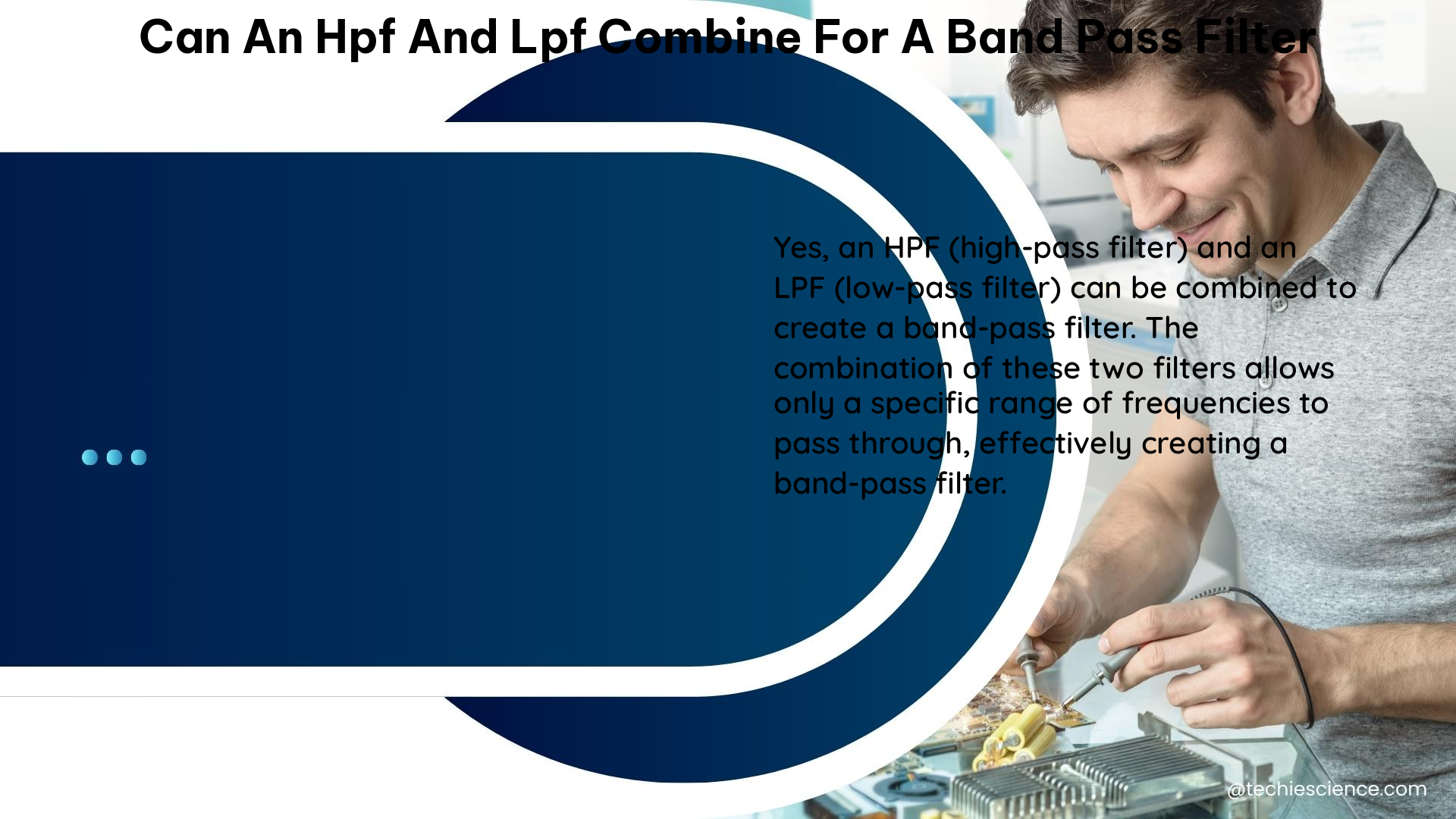In the realm of electronics, the question of whether High Pass Filters (HPF) and Low Pass Filters (LPF) can be combined to form a Band Pass Filter (BPF) is a topic of interest. The answer is yes, they can indeed be combined to create a BPF, but certain conditions must be met to ensure the desired performance.
Understanding Band Pass Filters
A Band Pass Filter is an electronic circuit that allows signals within a specific range of frequencies to pass through while attenuating signals outside that range. The center frequency of a BPF can be calculated using two equations, depending on the type of filter:
- Wide-Band Pass Filter: The center frequency is equal to the square root of the product of the two corner frequencies (f1*f2).
- Narrow-Band Pass Filter: The center frequency is equal to the average of the two corner frequencies ((f1+f2)/2).
Cascading HPF and LPF to Create a BPF

When cascading an HPF and an LPF to create a BPF, electrical isolation between the passive stages is required if the center frequency and corner frequencies are to be as calculated. Generally, the HPF is connected first, followed by the LPF. However, it is also possible to reverse the order, taking the output from the HPF and inputting it into the LPF. The performance of the BPF will not be affected by the order of the filters, as the HPF will attenuate signals below the cut-off frequency point, and the LPF will attenuate signals above the cut-off frequency point, regardless of the order.
Electrical Isolation Between Stages
Electrical isolation between the passive stages is crucial for accurate frequency response. This can be achieved by using a buffer amplifier or a voltage follower circuit between the HPF and LPF stages. The buffer amplifier ensures that the loading effect of the subsequent stage does not affect the performance of the previous stage.
Selecting Resistor and Capacitor Values
The magnitude of the output (Vo/Vi) in a passive filter circuit is not equal to 1.0 due to the inherent attenuation caused by the passive components. To achieve a higher magnitude (about 0.98), the selection of either R and C components must be carefully determined based on the required bandwidth of the particular application.
The ’10x’ rule is a good practice to follow when designing a multi-stage filter, where the resistor value of the newly added stage is increased by 10x to ensure minimal current is bled off into the next stage, preserving the behavior of the earlier stages.
For example, if the first stage (HPF) has a resistor value of 10 kΩ, the second stage (LPF) should have a resistor value of 100 kΩ. This ensures that the current flowing into the second stage is negligible compared to the current flowing through the first stage, maintaining the desired frequency response.
Advantages of Combining HPF and LPF for a BPF
- Flexibility in Frequency Selection: By adjusting the cut-off frequencies of the HPF and LPF, the center frequency and bandwidth of the BPF can be easily tuned to the desired specifications.
- Improved Selectivity: The combination of HPF and LPF provides better selectivity compared to a single-stage filter, as it can more effectively attenuate signals outside the desired frequency range.
- Reduced Noise and Interference: The BPF can effectively filter out unwanted signals, such as low-frequency noise and high-frequency interference, improving the signal-to-noise ratio.
- Modular Design: The modular approach of cascading HPF and LPF allows for easier troubleshooting, maintenance, and potential modifications to the filter design.
Practical Applications of BPF Filters
Band Pass Filters find applications in various electronic systems, including:
- Radio Frequency (RF) Circuits: BPFs are used in RF receivers and transmitters to select the desired frequency channel and reject unwanted signals.
- Audio Systems: BPFs are employed in audio equipment, such as equalizers and crossover networks, to isolate specific frequency bands for better sound quality.
- Instrumentation and Measurement: BPFs are used in spectrum analyzers, network analyzers, and other test equipment to isolate and analyze specific frequency components.
- Sensor and Monitoring Systems: BPFs are used to filter out unwanted noise and interference in sensor-based systems, improving the accuracy and reliability of measurements.
- Communication Systems: BPFs are essential in various communication technologies, such as AM/FM radio, cellular networks, and satellite communications, to ensure efficient signal transmission and reception.
Conclusion
In summary, HPFs and LPFs can be combined to form a BPF, and the order of the filters does not affect the performance. The center frequency of a BPF can be calculated using two equations, depending on the type of filter. Electrical isolation between the passive stages is required for accurate frequency response. The magnitude of the output in a passive filter circuit is not equal to 1.0, and careful selection of components is necessary to achieve the desired performance.
Reference:
- Passive Band Pass Filter – Electronics Tutorials: https://www.electronics-tutorials.ws/filter/filter_4.html
- Is Bandpass, a HP + LP in serial? – Keys, Synths & Samplers: https://www.harmonycentral.com/forums/topic/164613-is-bandpass-a-hp-lp-in-serial/
- Low Pass & High Pass Filter | All About Circuits: https://forum.allaboutcircuits.com/threads/low-pass-high-pass-filter.35033/
- How to combine a low pass and high pass filter into bandpass filter: https://www.reddit.com/r/learnpython/comments/1c4no0a/how_to_combine_a_low_pass_and_high_pass_filter/
- Frequency response of a low-pass, band-pass, and high-pass adder circuit: https://electronics.stackexchange.com/questions/596529/frequency-response-of-a-low-pass-band-pass-and-high-pass-adder-circuit

The lambdageeks.com Core SME Team is a group of experienced subject matter experts from diverse scientific and technical fields including Physics, Chemistry, Technology,Electronics & Electrical Engineering, Automotive, Mechanical Engineering. Our team collaborates to create high-quality, well-researched articles on a wide range of science and technology topics for the lambdageeks.com website.
All Our Senior SME are having more than 7 Years of experience in the respective fields . They are either Working Industry Professionals or assocaited With different Universities. Refer Our Authors Page to get to know About our Core SMEs.